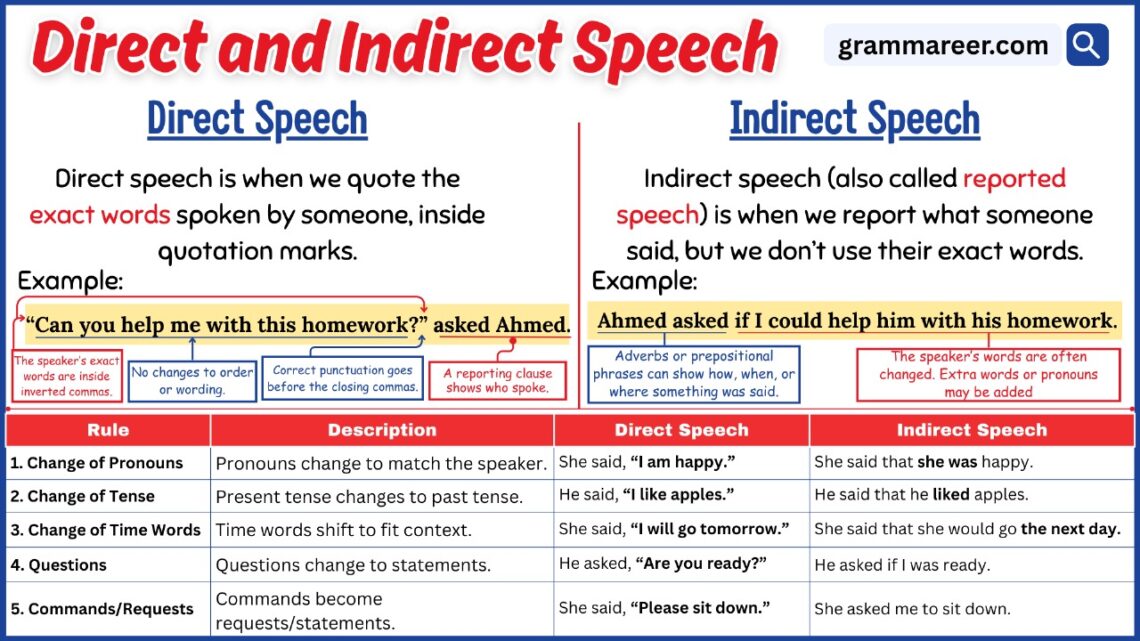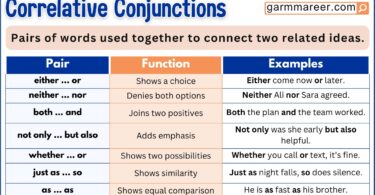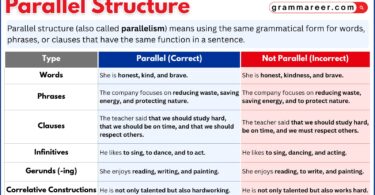When we write, we often include the words people say. This can be in the form of dialogue in a story, quotes in an article, or even retelling a conversation in a blog. There are two main ways to show spoken words in writing: direct speech and indirect speech. Both are important because they make our writing clear and easy to understand.
Knowing how to use direct and indirect speech helps you improve your writing and communication. This is especially useful in stories, news writing, school work, and even professional emails.
In this article, we’ll explain what direct and indirect speech are, show the differences, share some common mistakes, and give you easy examples to understand them better.
Learn more about grammar here.
Table of Contents
What is Direct Speech?
Direct speech is when you write exactly what someone says, word for word. It feels like you’re quoting them directly. That’s why you’ll usually see it inside quotation marks.
We use direct speech a lot in stories, interviews, or conversations because it brings the speaker’s voice to life. The grammar or sentence structure might not always be perfect, but that’s okay—it sounds real and natural.
Examples:
- Maria said, “I can’t find my notebook.”
- “Will you join us for lunch?” asked Ahmed.
- “Let’s go home now,” the children shouted.
What is Indirect (Reported) Speech?
Indirect speech is different. Instead of repeating the person’s exact words, you retell the message in your own words. This means the tense, pronouns, or even some expressions might change.
Examples:
- Direct: “I’m feeling tired,” said Ali.
- Indirect: Ali said that he was feeling tired.
- Direct: “Did you finish the project?” the teacher asked.
- Indirect: The teacher asked if I had finished the project.
Notice that in indirect speech: there are no quotation marks and the sentence is smoother and more flexible.
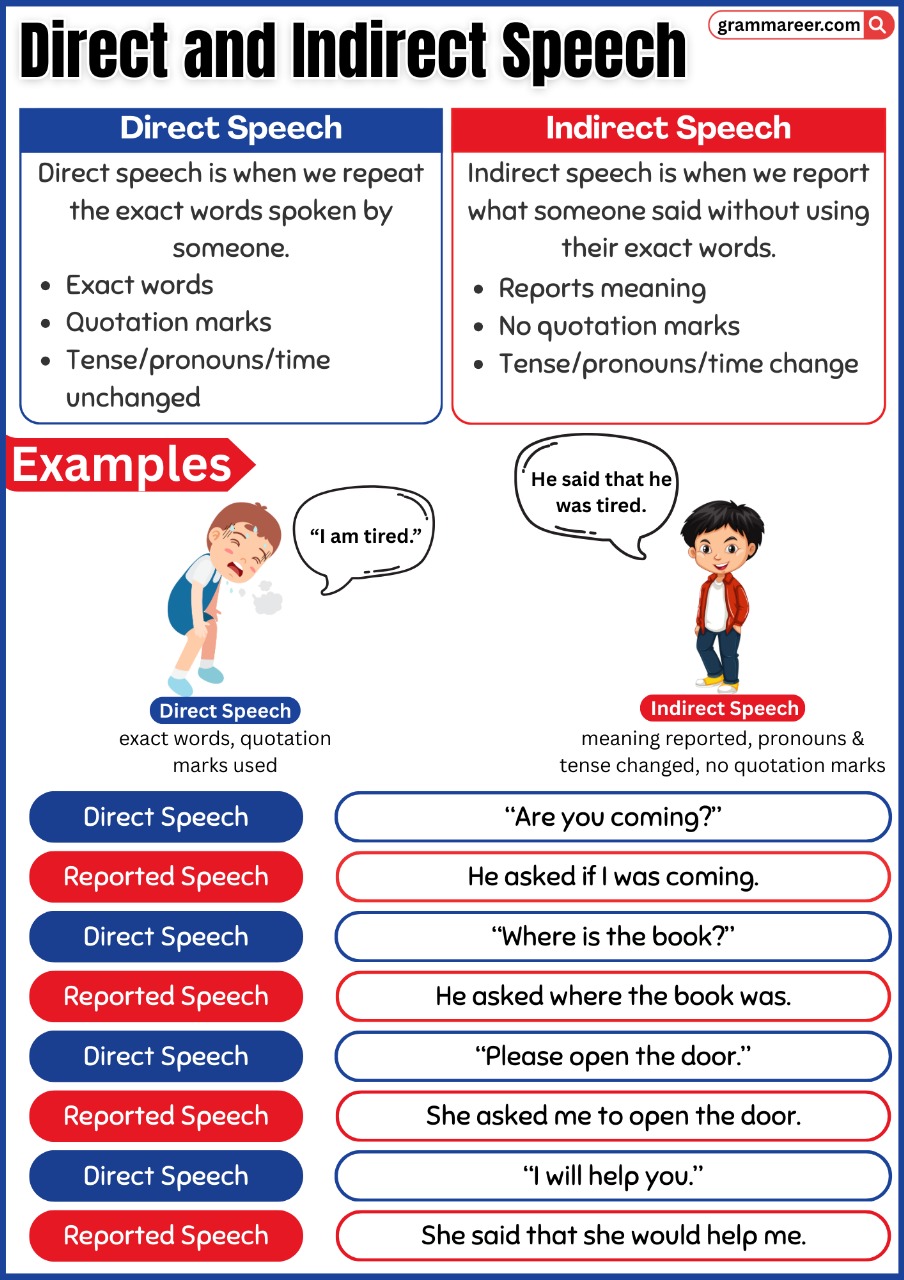
Difference Between Direct and Indirect Speech
Direct and indirect speech are both ways of showing what someone said, but they work differently. Let’s break it down step by step in simple terms.
1. Quotation Marks
- Direct speech always uses quotation marks because it shows the exact words.
- Example: “I like pizza,” said Rania.
- Indirect speech doesn’t use quotation marks.
- Example: Rania said that she liked pizza.
2. Pronouns
- Indirect speech changes pronouns to fit the reporter’s view.
- Example: Hira said it was her book.
- Direct speech keeps the same pronouns the speaker used.
- Example: “This is my book,” said Hira.
3. Tense Changes
- Direct speech keeps the original tense.
- Example: “I am studying right now,” said Bilal.
- Indirect speech usually shifts the tense backward.
- Example: Bilal said he was studying at that time.
4. Tone and Emotion
- Direct speech shows the speaker’s real tone and emotion.
- Example: “Don’t shout at me!” cried Amina.
- Indirect speech often softens the feeling.
- Example: Amina asked me not to shout at her.
5. Punctuation
- Direct speech needs special punctuation like commas and capital letters.
Example: Zayan said, “The train is late.” - Indirect speech follows normal sentence punctuation.
Example: Zayan said the train was late.
6. Structure
- Direct speech repeats the exact words of the speaker.
- Example: “Can you close the window?” asked Sara.
- Indirect speech rephrases the message.
- Example: Sara asked me to close the window.
When to Use Direct and Indirect Speech
We use direct and indirect speech in different situations.like:
- Use direct speech when the exact words really matter. For example, in a court statement, a news interview, or when you’re writing dialogue in a story.
- Use indirect speech when you just want to summarize or paraphrase what was said. It’s great for reports, academic writing, or whenever you need your text to flow smoothly without too many quotations.
Direct speech gives clarity and emotion, while indirect speech is often shorter and blends easily into formal writing.
Direct vs Indirect Speech in Everyday Use
Different styles of English also treat these forms differently:
- In British English, people often prefer indirect speech, especially in everyday conversation and news writing.
- In American English, direct speech is more common because it keeps the speaker’s exact words and tone.
Whatever you choose, be consistent. Mixing them too much in writing can confuse your reader. But in spoken English, people switch between the two all the time without a problem—it actually helps add variety and show emotion.
Using ‘Say’ or ‘Tell’
- Use say when you’re just reporting words, without mentioning who they were said to.
- He said he was tired.
- Use tell when you do mention the person being spoken to.
- He told me he was tired.
Note: If there’s an object like me, you, her, us, etc., use tell. If not, go with say.
Using ‘Talk’ or ‘Speak’
- Both talk and speak mean “to use words to communicate.”
- He talked to us.
- She was speaking on the phone.
- When you want to mention the topic, use about with either verb.
- He talked about his parents.
- She spoke about her new job.
Quick note: Talk is more casual, while speak feels a bit more formal.
Rules for converting Direct into Indirect speech
When we change direct speech to indirect, a few small things usually shift — like tenses, pronouns, time words, and even punctuation. Let’s break it down step by step, nice and easy.
Rule 1: Change the tense when reporting in the past
If the reporting verb (said, told, asked) is in the past, the verb usually moves one step back.
- Present simple → Past simple
- Present continuous → Past continuous
- Will → Would
- Can → Could
Example:
- Direct: He said, “I am happy.”
- Indirect: He said that he was happy.
Rule 2: Don’t always change the tense
You don’t need to backshift in some cases:
- If the reporting verb is in the present or future.
Direct: She says, “I love books.”
Indirect: She says she loves books. - If it’s a fact or universal truth.
Direct: The teacher said, “The sun rises in the east.”
Indirect: The teacher said the sun rises in the east. - Sometimes for style, we keep the tense the same to make it sound fresh.
Direct: “You must try harder,” the coach said.
Indirect: The coach said we must try harder.
Rule 3: Adjust pronouns
Change pronouns according to who is speaking and who is listening.
- I → he/she
- You → I/he/she/they
- We → they
Example:
- Direct: Sara said, “I will help you.”
- Indirect: Sara said that she would help me.
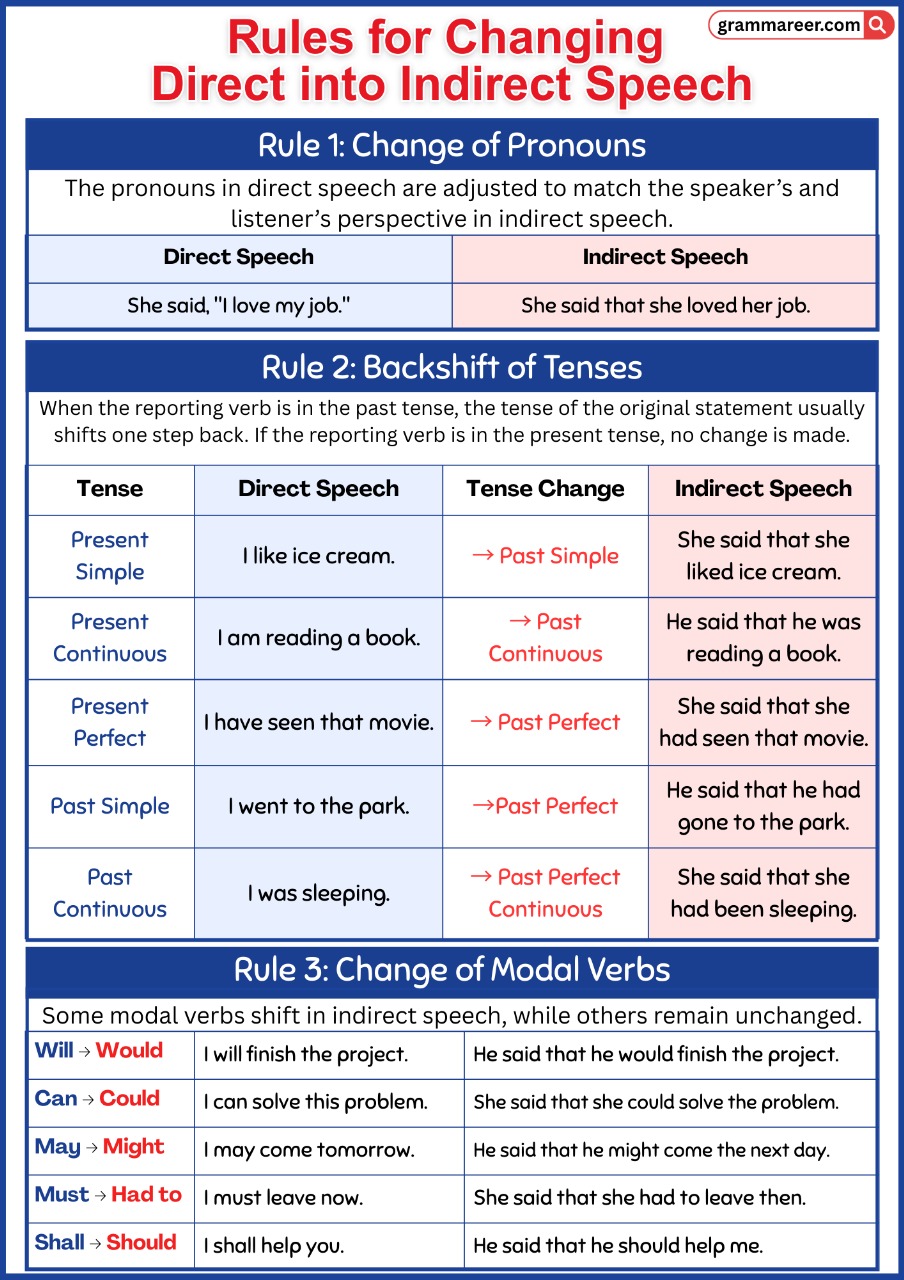
Rule 4: Change time and place words
- now → then
- today → that day
- tomorrow → the next day
- yesterday → the previous day
- here → there
- this → that
Example:
- Direct: He said, “I’ll go there tomorrow.”
Indirect: He said that he would go there the next day.
Rule 5: Be careful with longer sentences
When the sentence has more than one action, make sure everything matches.
Example:
- Direct: She said, “I will finish my work and then call you.”
- Indirect: She said she would finish her work and then call me.
Rule 6: Drop “that” in casual speech
In everyday conversation, people often leave out “that.” But in formal writing, it’s safer to keep it.
Example:
- Direct: He said, “I’m tired.”
- Indirect (formal): He said that he was tired.
- Indirect (casual): He said he was tired.
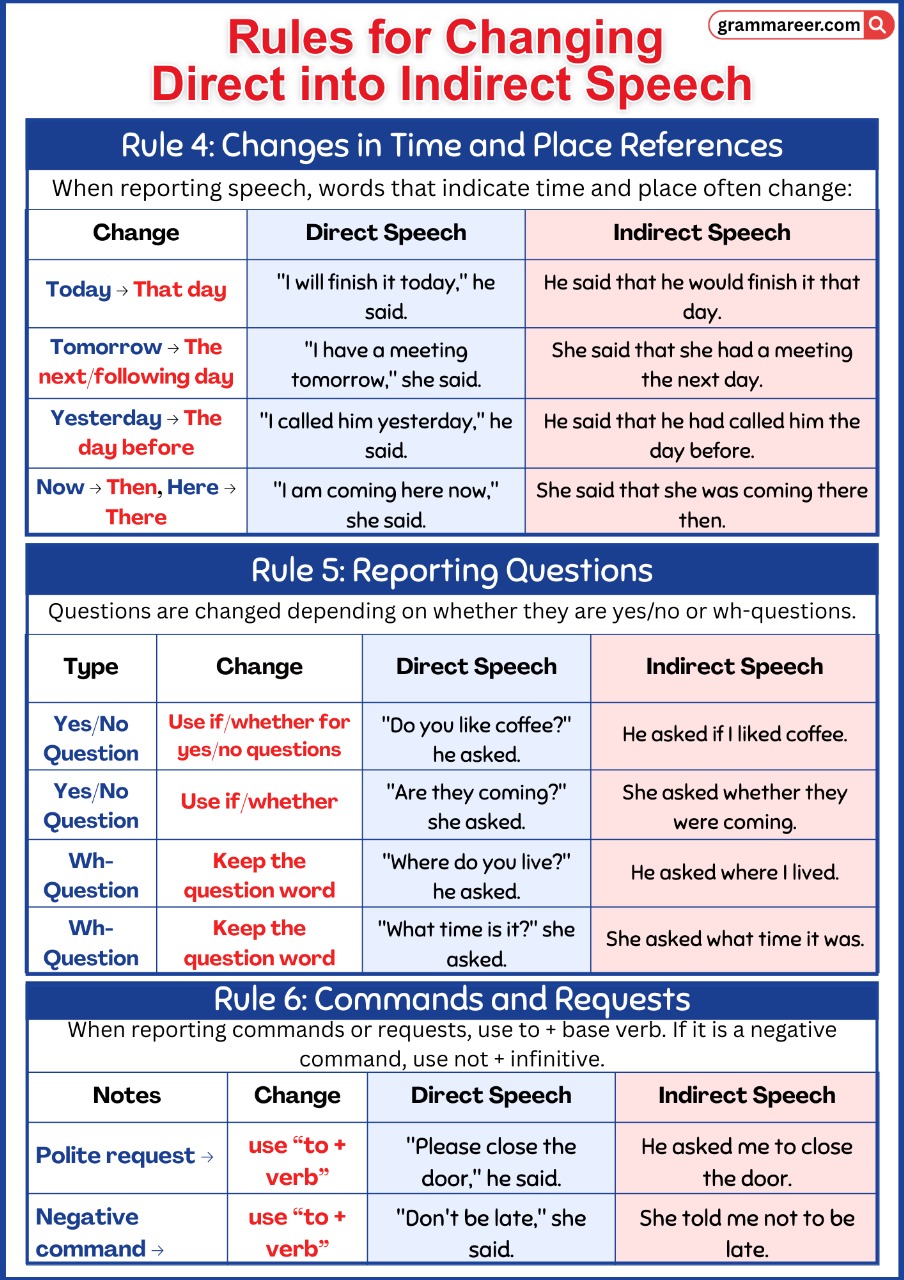
Rules for Changing Indirect into Direct Speech
Turning indirect speech back into direct isn’t hard at all. Think of it like “bringing the words back to life.” Just keep these in mind:
- First, pick the right reporting verb.
- Indirect: She said that she was happy.
- Direct: She said, “I am happy.”
- Always add a comma before the quoted part, and start it with a capital letter.
- Indirect: He said that he was late.
- Direct: He said, “I am late.”
- Pay attention to the ending—use a question mark, exclamation mark, or full stop, depending on the mood.
- Indirect: She asked if I was ready.
- Direct: She asked, “Are you ready?”
- Cut out extra words like that, if, whether, or to if they’re not needed.
- Indirect: He said that he liked tea.
- Direct: He said, “I like tea.”
- Fix the tense back to how it originally was.
- Indirect: She said that she was tired.
- Direct: She said, “I am tired.”
- or past perfect, you’ve got two choices—change it to past simple or keep it as present perfect.
- Indirect: He said that he had finished his work.
- Direct: He said, “I finished my work.” / “I have finished my work.”
Direct and indirect speech Examples
| Direct Speech | Indirect Speech |
| • She said, “I am tired.” | • She said that she was tired. |
| • He said, “I like pizza.” | • He said that he liked pizza. |
| • They said, “We are going to the park.” | • They said that they were going to the park. |
| • She asked, “Are you coming?” | • She asked if I was coming. |
| • He said, “I will call you tomorrow.” | • He said that he would call me the next day. |
| • She said, “I have finished my homework.” | • She said that she had finished her homework. |
Common Mistakes with Direct and Indirect Speech
- Tense mix-ups: A lot of learners forget to change the tense when moving to indirect speech.
Example:- ❌ She said she is happy.
✔ She said she was happy.
- ❌ She said she is happy.
- Pronoun confusion: If you keep the same pronouns, the sentence can get confusing.
Example:- ❌ He said I am tired.
✔ He said he was tired.
- ❌ He said I am tired.
- Time and place words: Words like today, tomorrow, here, now don’t stay the same in indirect speech.
Example:- ❌ She said she would come here tomorrow.
✔ She said she would come there the next day.
- ❌ She said she would come here tomorrow.
- Mixing styles: Some people accidentally use direct and indirect in the same sentence. It sounds odd.
Example:- ❌ She said “I love it and that she would buy it.”
✔ She said she loved it and would buy it.
- ❌ She said “I love it and that she would buy it.”
You May Also Like

